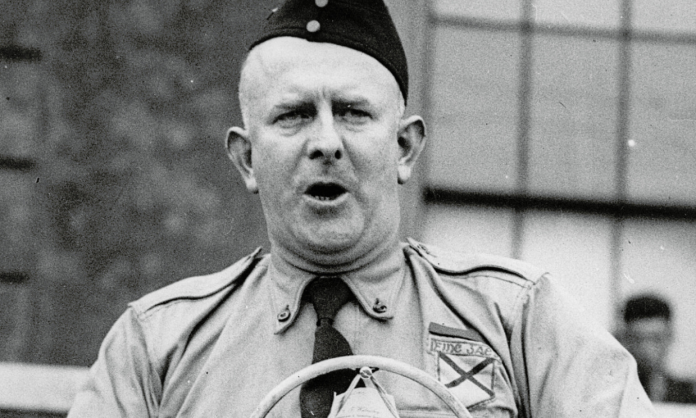If Eoin O’Duffy had not become Commissioner of An Garda Siochana in September 1922 it could be stated that the link between An Garda Síochana and the GAA would be quite different today.
He was a person possessed of indefatigable energy, a born organiser and a tireless worker. He placed a very strong emphasis on sport as he recognised that the RIC had never integrated culturally with the people consequently ensuring that Gaelic games were fostered with great enthusiasm within An Garda Síochana.
O’Duffy ensured that members of An Garda Síochana became a focal point throughout the country resulting in many young people being coached as hurlers, footballers and handballers by friendly members of An Garda Siochana. Indeed this Garda support provided a badly needed stimulus in areas where native games had previously not gained local acceptance.
O’Duffy had been involved in administrative positions with the GAA back in 1910 in Monaghan where he was elected as Secretary of the County Board there in 1912. As far as can be ascertained he never played football or hurling but used his administrative talents to great effect in fostering Gaelic games particularly among the new Garda force after he became Commissioner in 1922.
He is given much of the credit for the emergence of a respected non-political and unarmed police force despite being a controversial figure in Irish society. He insisted on a Catholic nationalist ethos to distinguish his force from their RIC predecessors and importantly instructed all members to avoid the use of alcohol of which he was a vocal opponent.
Eoin O’ Duffy was born in Laragh, Castleblayney, Co Monaghan in October 1890 and died in a Nursing Home in Ballsbridge, Dublin in 1944 aged 54. He received a State funeral and was buried in Glasnevin Cemetery not far from Michael Collins, after Mass in the Pro Cathedral in Dublin. In his retirement years he is reported as stating that he had made two mistakes in his life – that he had not married and that he had entered politics.
To date he is the only native of Monaghan given a State funeral. In 1926 Eoin O’ Duffy attended an International Police Conference in New York where he was interviewed by the Editor of the New York Evening Post who stated in his subsequent article that O’Duffy was one of the most popular police chiefs attending the conference.
That editor penned the following – “Although he proved one of King George’s most rebellious subjects, together with Michael Collins and Arthur Griffith, General O’Duffy has brought peace and quiet to Ireland in the 4 years since he headed the police force. Although no man was more ready than General O’Duffy to seize a gun and fight for the cause of Ireland in the days of guerrilla warfare against the King’s men, today not one of his Policemen, 7,000 in all, carries a gun of any description” .
Here is the most unusual description given by that editor of the New York Evening Post back in 1926. “General Eoin O’Duffy has just turned thirty two and the average age of his Civic Guard is twenty three. This man who carried a price on his head for three years, never lost the smile in his blue eyes nor the lightning power of his right arm. He has a laugh for a friend, a blow for a foe, and looks at the world straight in the eye.
Standing as straight as an arrow, lean and strong, and looking remarkably well set up in his blue tunic and slacks, black Sam Brown belt and scarlet insignia of rank, General O’Duffy inspires confidence in his ability to keep turbulent Ireland in the palm of his hand. He knows his Irish and has shed his blood for them in the conflict with England. Three times he was wounded – you will look in vain for the index finger of his right hand, shot off in one of his numerous engagements.
He was with Michael Collins earlier in the day when the leader was shot down in ambush and escaped three times from ambuscades. His words stream out in a sharp crackle, like a machine gun burst. When his thin lips are un smiling they make a firm hard line at right angles to a thin hawk nose. His Irish blue eyes freeze suddenly into two points of ice.”
During that interview O’Duffy stated as follows – “I had no special qualification for a Policeman. Organisation was my forte. The Guard needed that. The RIC members could not be taken back because of the part they played in the war with England. The Irish had been looking long for an unarmed, non sectarian, non political force. We gave them that. We will serve any Government chosen by the Irish people.
I have no interest in or time for politics. I work 17 hours a day. The only holiday I have taken has been to attend the 1923 Conference and this one. We have an efficient Police force in Ireland. The men are young, very hard worked and have the confidence of all sections of the people and they are recognised for their courtesy and efficiency”.
General Eoin O’ Duffy, although a controversial figure in Irish society, must be given credit for the part he played during the 10 years he was Commissioner of An Garda Síochana and his great involvement with the GAA. As stated by Conor McMorrow in his book – Dáil Stars published in 2010 – “O’Duffy left a legacy in the GAA and Irish sport that should not be forgotten”.
It has to be acknowledged that due to O’Duffy’s encouragement and guidance there are now 127 Garda footballers holding Senior All Ireland medals and 89 members holding Senior All Ireland Hurling medals. No other single organisation in this state can boast such a tremendous collection. General Eoin O’ Duffy was dismissed by the De Valera Government on February 27th, 1933.








